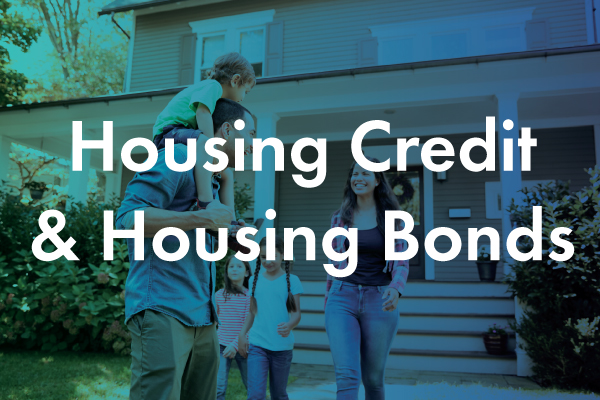Housing Credit & Housing Bonds
Ask: To include expanded resources for affordable housing in the reconciliation tax legislation and to convey their support for affordable housing in the tax bill to party leadership and the Senate and House tax-writing committees.
-
Expand 9 percent Housing Credit authority by at least 50 percent, including by reinstating the 12.5 percent cut in Housing Credit resources the program suffered beginning in 2022.
-
Lower the bond financing threshold to promote more affordable housing production with the 4 percent Credit and tax-exempt multifamily bonds.
-
Allow states to provide “basis boosts” to Housing Credit properties serving extremely low-income households and to developments located in rural and Native American areas and for 4 percent properties that need the boost for financial feasibility.
Ask: To protect tax-exempt private activity bonds (PABs), including Housing Bonds, and expand the reach of Housing Bonds.
-
Temporarily — for a five-year period — remove multifamily Housing Bonds and Mortgage Revenue Bonds from the PAB cap.
-
Retain the PAB tax exemption, which is critical to the work HFAs do to increase the supply of affordable rental housing and help first-time lower-income home buyers achieve the American dream of homeownership. Eliminating the PAB tax exemption should not be used to offset the cost of the tax bill.
Why is it important to include housing in the major tax bill under consideration in 2025?
- Republicans have long supported using the tax code to incent private-sector investment in affordable housing through the Housing Credit and Housing Bonds. These programs are public-private partnerships administered at the state level to optimize efficiency and maximize outcomes.
- The Housing Credit provisions we are seeking to include in the tax bill this year are part of standalone legislation — the Affordable Housing Credit Improvement Act (AHCIA) — which has received wide support from congressional Republicans. In the 118th Congress, 122 House and 17 Senate Republicans cosponsored this legislation.
- With the support of President Trump, Congress in 2018 expanded the Housing Credit by 12.5 percent, but that expansion expired at the end of 2021. Congress should restore that increase and further expand Housing Credit authority by 50 percent.
- A modest increase in Housing Credit authority and a lower bond financing test were included in the 118th Congress’s Tax Relief for American Families and Workers Act, which passed the House by a vote of 357 – 70. This strong vote in favor of the bill included large majorities of both House Republicans and Democrats. While the legislation did not ultimately advance in the Senate, this was due to issues unrelated to housing and there was strong support for the affordable housing provisions it contained.
- Temporarily exempting Housing Bonds from the PAB cap would provide much needed housing supply and allow states and local governments to help more lower income home buyers to ease the housing crisis until inflation cools and mortgage interest rates return to more manageable levels.
Housing Credit and Multifamily Bond Keynotes
- High housing costs are a major driver of inflation, with shelter being the largest contributor to the monthly increase in prices, according to the Consumer Price Index. The cost of renting an apartment has skyrocketed across the nation, with average rent being 29.4 percent higher than before the pandemic. A primary reason for this increase is the imbalance between the supply of rental housing and demand for it.
- The Housing Credit recently suffered a substantial cut in its resources when a 12.5 percent cap increase put in place in 2018 expired at the end of 2021. This cut in authority came at the absolute worst time, with rents rising to historic levels due to the supply/demand imbalance and construction costs escalating with inflation.
- The Housing Credit and Multifamily Bonds are vital tools for addressing the rental housing crisis. There currently is a shortage of more than 7.3 million affordable units for extremely low-income (ELI) renters, with only 34 affordable and available units for every 100 ELI renter households nationwide. Seventy-four percent of ELI renters are spending more than half of their income on housing.
- Unlike many other tax expenditures, which subsidize activity that would occur at some level without a tax benefit, virtually no affordable rental housing development would occur without the Housing Credit and Housing Bonds. Housing simply costs too much to build for owners to charge rents that are affordable to low-income households.
- The Housing Credit and Housing Bond programs have a unique, market-based structure that transfers the real estate risk from the taxpayer to the private-sector investor. In the rare event a property falls out of compliance at any time during the first 15 years after it is placed in service, the Internal Revenue Service can recapture tax credits.
- Thus, investors have an incentive to ensure properties adhere to all program rules, including affordability restrictions and high quality standards.
- The Housing Credit and Housing Bond programs require only limited federal bureaucracy, because Congress delegated its administration and decision-making authority to state governments. State housing finance agencies (HFAs), which administer the Housing Credit in nearly every state, have statewide perspective, a deep understanding of the needs of their local markets, and sophisticated finance, underwriting, and asset management capacity.
- The National Association of Home Builders (NAHB) estimates that every 100 new Housing Credit units built support 190 jobs and generate $7.9 million in tax revenue and $21.6 million in wages and business income. NAHB estimates that every 100 units rehabilitated with the Housing Credit support 131 jobs and generate $5.1 million in tax revenue and $14.5 million in wages and business income.
- With strict state agency underwriting standards, stringent compliance requirements, and due diligence from the private sector, the inventory of Housing Credit properties, including those with Housing Bond financing, has an outstanding performance track record according to all commonly used real estate metrics. Only 0.5 percent of Housing Credit developments have undergone foreclosure, an unparalleled record compared to market-rate multifamily properties and all other real estate classes.
- The Housing Credit has financed at least 15 percent of all new multifamily housing in 40 states.
MRBs and MCCs Keynotes
- A healthy and affordable home purchase market is crucial for economic growth. Homeownership is many working families’ primary means of building wealth. Further, an active home purchase market would open up more rental opportunities for those wishing to rent as new home buyers leave their rentals.
- The Mortgage Revenue Bond and Mortgage Credit Certificate programs make homeownership possible for first-time, lower-income home buyers. MRBs and MCCs are essential to state housing finance agency efforts to help low- and moderate-income working families become home buyers.
- MRBs enable creditworthy working families with modest incomes and limited capacity to obtain the necessary down payments to access homeownership. Using MRBs, state HFAs have helped more than 3.5 million responsible low- and moderate-income borrowers become homeowners. They help approximately 80,000 families buy their first homes with MRB mortgages, on average, each year.
- In today’s high-interest rate market, MRB loans are critical to helping working families purchase a home. Many HFAs are able to offer MRB-financed mortgage products with interest rates 0.5 to one percent below the prevailing market rate, saving borrowers thousands annually and allowing them to make more competitive bids on starter homes.
- MRBs are well targeted to help those who most need it. The median income of an MRB borrower in 2023 was $68,220, 85 percent of the national median. The average sales price of an MRB-financed home was just over $223,445, 44 percent of the national median sales price.
- The MCC program is a flexible subsidy source. It can be adjusted depending on the incomes of different home buyers and provides a relatively constant level of benefit to first-time home buyers. State HFAs have used MCCs to provide critical tax relief to nearly 404,000 families.
- MRBs and MCCs also provide other important indirect benefits by helping the sale of homes under foreclosure, revitalizing distressed neighborhoods, bringing mortgage funds into capital-deprived areas, and funding the repair and purchase of homes in older, urban communities.

